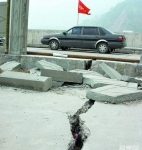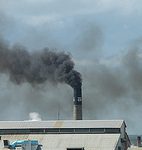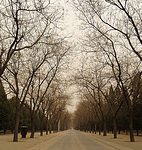The shock of the many deaths caused by the May 12 earthquake that shook China’s southwest Sichuan province has begun to subside, and attention is now turning to the plight of the survivors. In late August academics from Guangzhou, south China, and researchers from a citizen’s group visited Sichuan to see how communities are being rebuilt. They found that although notable progress has been made, there are still some lingering problems.
Along with taking tens of thousands of lives and destroying property worth tens of billions of yuan, the earthquake also damaged the ecological balance in the region. Hard-hit areas such as Pengzhou and Dujiangyan are home to national forests, nature reserves and cultural heritage sites. Over 1,550 kilometres of forest roads, 26,670 hectares of forest, and vegetation covering 10,000 hectares of the Baishui River Nature Reserve have been damaged or destroyed. Huge quantities of antiseptic disinfectants are threatening to pollute rivers that are sources of drinking water. In some areas the rubble and human remains have yet to be cleared, increasing the risk of disease and further building collapses. Although these these areas have been declared “no-go zones,” they are sometimes little more than a kilometre – and sometimes only several hundred metres – away from the prefabricated buildings housing survivors. These circumstances make the living in earthquake devastated areas a bleak prospect.
At the same time, there are environmental risks associated with the methods used to shelter quake victims. Many are still living in tents without proper shelter. The quality of the prefabricated buildings that have been erected is poor due to the haste with which they were constructed. For instance, one area of Dujiangyan housing is filled with waist-deep water caused by heavy rain. Even properly constructed temporary buildings may not be able to sustain the trials of winter: a normal winter will be no problem, but if there are constant blizzards, such as China experienced earlier this year, there is often significant damage. Obtaining basic utilities is also a problem. For example, one community has had to use an untreated source of drinking water since the time the army left the area. Volunteers recently contacted a factory in Foshan and donated a water purifier, providing a partial solution to the situation.
Supplying prefabricated homes and tents is considered the top priority, with environmental concerns currently taking second place. However, after two or three years the environmental and health issues will have to be addressed. Many former rural residents are now living in temporary accommodation; these living conditions are creating waste management and drinking water supply issues.
The housing itself also has a major environmental impact. Many sites are on arable land. Even with the farmers receiving compensation, there is a question of the farmers’ future livelihoods and the recovery of the land itself. The prefabricated houses have been built on concrete foundations, causing a loss of soil. The environment has a very limited capacity, and ignoring these issues could be disastrous.
Along with the efforts of the victims themselves, provision of shelter and reconstruction has been carried out by three main groups: the army, local government and volunteers. As of late August, rescue and initial resettlement work drew to a close, and the army has pulled out. As university terms start again, many student volunteer groups will also leave. Now the bulk of the work will fall on the shoulders of the local government, and it will test their abilities to the limit.
The major problem facing local government reconstruction workers is the sheer scale of the project. About 4.5 million households and 10 million people have been affected by the earthquake and require shelter and assistance. One party secretary speaking to volunteers was obviously exhausted, having had no time to rest. Under the current system the government will undertake the bulk of the public work, but it lacks sufficient time to address all the needs of the quake victims.
Without systematic oversight, the allocation of resources is carried out by local officials. This causes other problems: recent television reports cite disaster relief funds being used for office supplies and administrative costs. More common is the unfair distribution of goods. In one area, some prefabricated buildings are occupied by only one or two people, or even stand empty, while 700 families live in tents and wait to be housed. Well-worn patterns of resource distribution continue: everyone may have been made equal by the earthquake, but old stratifications have quickly reappeared. The differences are made even more apparent when the two types of housing are located only metres apart, causing fierce discontent.
Once shelter has been provided, homes must be rebuilt. Many counties have proposed “ecological reconstruction” plans, relying on scenic areas and local agricultural products to create tourism and “circular economy” models. Although this is the best choice in terms of environmental protection, this idea quickly encountered problems with regards to the existing land policy. Developing the tourist industry involves the buying and selling of land. In Pengzhou small farming households used to earn their income from the tourism industry, a situation that ended with the collapse of thousands of homes providing “rural experiences”. If they are to be rebuilt in their original locations, investors must be brought on board. However, the law forbids the selling of rural land (including housing sites), creating an obstacle to attracting funding. Even proposed partnerships in Chengdu, the capital of Sichuan, in which urban residents would fund reconstruction in exchange for a percentage of the buildings, have run into rural land policy problems.
Problems with survivors’ living conditions remain. The most pressing is the basic conditions of shelter, but water sources need to be protected, with designated spots constructed for the disposal of domestic waste water. The use of specific rubbish disposal points should be enforced. Temporary toilets need to be built, and where possible, water-free ecological toilets. Democratic processes and neighbourhood agreements would change the residents’ habits and ensure health and hygiene.
Realistic plans are needed for reconstruction; not every area is suitable for ecological reconstruction. Some places were not even fit for human habitation before the quake, and now conditions are even worse. In these cases only large-scale relocation is an option. Where possible, ecological reconstruction should be accompanied with the reallocation of land to locals. Varied investment and reconstruction methods should be used. This reconstruction will require innovation and policy support from the government.
Moreover, non-governmental organisations must be brought into play. The scale of the issues at hand means that the government needs significant help from NGOs, which now play a secondary role at the fringes of quake-hit areas. This is primarily due to the imperfect development of civil society in China, the uncertain status of NGOs, and the delicate relationship between NGOs and the government. The current situation is an opportunity to redefine the NGO-government relationship and for civil society groups to grow. It will be a tragedy if NGOs are unable to provide important services.
The earthquake has damaged the balance of the natural environment. If humans are to help it recover, society needs to be balanced.
Tang Hao, born in 1974, is a newspaper columnist, deputy editor of Shimin (Citizen) magazine, and assistant professor of politics at Huanan Normal University. His essays and opinion pieces have appeared in Contemporary International Relations, International Studies, Nanfang Daily, Yangcheng Evening News, Southern Window and many other publications.




